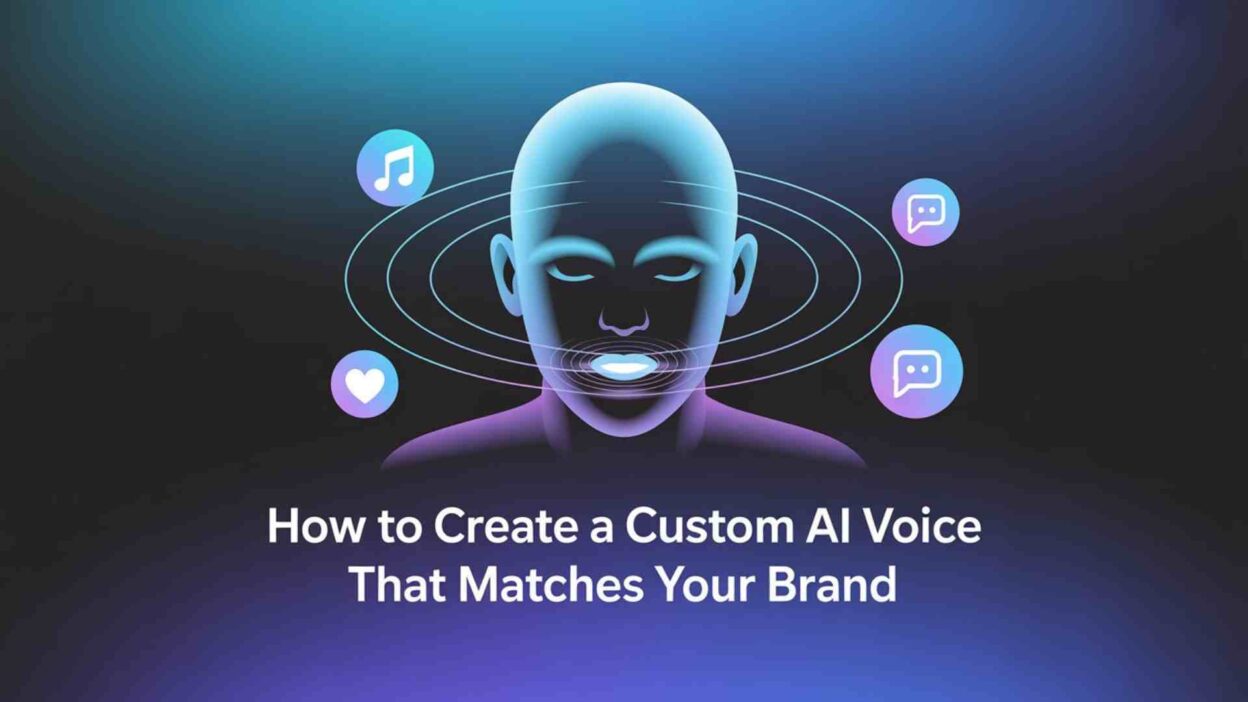TL;DR Your brand has a personality. Every logo, color, and message reflects your values. Your voice matters just as much as your visual identity. Audio branding creates lasting impressions that customers remember clearly.
Table of Contents
AI voice technology transformed how businesses communicate with audiences. Generic voices sound robotic and impersonal to listeners. Custom voices embody your brand’s unique character authentically. The right voice builds trust and strengthens customer connections.
Learning to create custom AI voice for brand identity opens new opportunities. You can deliver consistent experiences across all touchpoints. Customers recognize your voice instantly wherever they hear it. This guide walks you through the entire creation process step by step.
Understanding AI Voice Technology and Brand Identity
What Makes AI Voices Different
Traditional text-to-speech systems sound mechanical and unnatural to human ears. Modern AI voices use neural networks to mimic human speech patterns. Deep learning analyzes thousands of hours of voice recordings. The technology captures nuances like emotion, pacing, and natural inflection.
Synthetic voices now sound remarkably close to real human speakers. Listeners struggle to distinguish between AI and actual people. The technology continues improving with each software update released. Quality differences between providers remain significant despite overall advancement.
The Importance of Voice in Branding
Your brand voice extends beyond written content and visual design. Audio represents a powerful sensory connection with your audience. People remember voices longer than they remember written words. Voice creates emotional resonance that text alone cannot achieve.
Consistency matters enormously across all customer interaction points. Your phone system should match your video content perfectly. Podcast intros need to align with your app notifications. When you create custom AI voice for brand consistency, recognition improves dramatically.
Voice characteristics communicate personality traits instantly to listeners. A warm, friendly tone suggests approachability and customer care. Professional, authoritative voices build credibility and trust quickly. Energetic voices convey innovation and youthful energy effectively.
Matching Voice to Brand Personality
Every brand possesses distinct personality traits worth highlighting intentionally. Luxury brands require sophisticated, refined vocal qualities throughout communications. Tech startups often choose modern, enthusiastic voice characteristics. Healthcare organizations need compassionate, trustworthy vocal tones always.
Your target audience demographics influence voice selection significantly too. Younger audiences respond well to casual, conversational speaking styles. Professional B2B clients prefer polished, articulate communication approaches. International audiences may need neutral accents for clarity.
Brand values should shine through every spoken word clearly. Sustainability-focused companies might choose earthy, genuine vocal qualities. Financial institutions typically select confident, stable voice characteristics. Entertainment brands can experiment with playful, dynamic vocal styles.
Defining Your Brand Voice Characteristics
Tone and Personality Traits
Start by identifying three to five core personality traits. Your brand might be friendly, knowledgeable, and approachable simultaneously. Perhaps you’re innovative, bold, and inspiring to customers. Write these traits down before moving forward with creation.
Tone refers to the emotional quality your voice carries. Optimistic tones uplift listeners and create positive associations. Serious tones convey importance and demand attention appropriately. Conversational tones make complex information feel accessible to everyone.
Formality levels range from casual to highly professional language. Casual voices use contractions and everyday language naturally. Formal voices employ complete sentences and proper grammar consistently. Your industry and audience determine appropriate formality levels.
Pace and Rhythm Considerations
Speaking speed dramatically affects how audiences perceive your message. Fast-paced voices suggest energy, excitement, and urgency effectively. Moderate speeds feel comfortable and easy to follow. Slow, deliberate pacing conveys thoughtfulness and importance clearly.
Rhythm involves the pattern of emphasis and pauses throughout speech. Natural rhythm prevents monotone delivery that bores listeners. Strategic pauses give audiences time to process information properly. Emphasis on key words highlights important concepts effectively.
When you create custom AI voice for brand applications, rhythm matters enormously. Consistent rhythm creates a signature sound audiences recognize. Varying rhythm keeps longer content engaging throughout duration. Test different rhythm patterns to find your brand’s sweet spot.
Accent and Regional Considerations
Accent selection impacts audience connection and message clarity substantially. Neutral accents work well for global audiences seeking universal appeal. Regional accents create strong local connections with specific markets. British accents often convey sophistication and authority to listeners.
American accents vary significantly from New York to California. Southern accents feel warm and hospitable to many ears. Midwestern accents sound friendly and trustworthy to most audiences. Coastal accents might suggest innovation and forward-thinking approaches.
International brands face complex accent decisions across different markets. A single global voice simplifies operations and builds consistency. Multiple regional voices demonstrate local market respect and understanding. Budget and strategy determine which approach works best.
Emotional Range Requirements
Some brands need wide emotional range across different contexts. Customer service scenarios might require empathy and patience. Marketing messages might demand enthusiasm and excitement levels. Educational content needs clarity and encouragement throughout delivery.
Technical limitations affect emotional expression in AI voices currently. Basic systems offer limited emotional variation within recordings. Advanced platforms provide granular control over emotional qualities. Premium services create voices with extensive emotional capabilities built in.
Document specific emotional states your voice needs to convey. Happy, sad, excited, concerned, and neutral represent common requirements. Certain industries need specialized emotions like urgency or calmness. Your voice provider should demonstrate these capabilities before purchase.
Choosing the Right AI Voice Technology Platform
Leading AI Voice Providers
ElevenLabs leads the market with exceptionally realistic voice cloning. Their technology captures subtle nuances other platforms miss entirely. Voice quality rivals professional voice actor recordings consistently. Pricing scales from individual creators to enterprise organizations.
Murf.ai offers extensive voice libraries with customization options. Their studio interface makes voice generation straightforward and intuitive. Multiple languages and accents come standard across all plans. Collaboration features help teams work together on projects.
Play.ht specializes in long-form content like audiobooks and podcasts. Their voices maintain consistency across hours of spoken content. Emotional controls let you adjust delivery for different passages. API access enables integration with existing content workflows.
Resemble.ai focuses on enterprise voice cloning and customization. Their technology creates voices from minimal sample recordings. Voice management systems handle multiple brand voices efficiently. Security features protect your proprietary voice assets carefully.
Key Features to Evaluate
Voice quality represents the most critical evaluation factor always. Request samples that match your intended use cases exactly. Listen for naturalness, clarity, and lack of robotic artifacts. Compare multiple providers using identical test scripts thoroughly.
Customization depth determines how closely you can match brand requirements. Some platforms offer basic pitch and speed adjustments only. Advanced systems provide control over dozens of voice parameters. When you create custom AI voice for brand precision, deeper customization helps tremendously.
Language support matters for businesses serving international markets significantly. Verify that your target languages sound natural and clear. Some providers excel in English but struggle with other languages. Native speakers should evaluate non-English voice quality independently.
Integration capabilities affect implementation ease across your technology stack. API access enables automation of voice generation workflows. Direct integrations with popular platforms save development time substantially. Webhook support allows real-time voice generation when needed.
Pricing Models and Budget Planning
Subscription plans work well for ongoing voice generation needs. Monthly fees provide predictable costs for budgeting purposes easily. Usage limits vary by tier from thousands to millions of characters. Overage charges apply when you exceed your plan limits.
Pay-as-you-go pricing suits occasional voice generation requirements better. You pay only for the exact amount of content generated. Per-character or per-second rates determine total costs ultimately. This model offers flexibility without long-term commitments required.
Enterprise licensing provides unlimited usage for large organizations typically. Custom pricing reflects your specific volume and feature requirements. Dedicated support and priority processing justify higher costs often. Service level agreements guarantee uptime and performance standards.
Budget considerations extend beyond just the voice platform costs. Professional voice actor recordings for training data cost money. Audio editing and post-production require time or contractor expenses. Ongoing optimization and updates need resources allocated appropriately.
Technical Requirements and Limitations
Audio quality depends on sample recordings when creating custom voices. Higher quality inputs produce better output results consistently. Professional recording equipment captures necessary detail for cloning. Background noise and audio artifacts degrade final voice quality.
Storage requirements grow as you generate more voice content. Audio files consume significantly more space than text files. Cloud storage integrations help manage large content libraries. Local storage works for smaller implementations with limited content.
Processing time varies based on content length and platform capacity. Real-time generation enables immediate voice output for applications. Batch processing handles large volumes more efficiently overnight. Understanding processing times helps plan content production schedules.
Technical expertise requirements differ dramatically across various platforms. No-code interfaces let marketing teams generate voices independently. API implementations require developer resources and technical knowledge. Evaluate your team’s capabilities honestly before platform selection.
The Voice Creation Process Step by Step
Recording Sample Audio
Professional voice actor selection starts your voice creation journey. Choose actors whose natural voice aligns with brand characteristics. Their existing tone and style should match your requirements closely. Casting multiple actors lets you compare options directly.
Recording quality cannot be emphasized enough for successful cloning. Professional studios eliminate background noise and room echo completely. High-quality microphones capture frequency ranges essential for natural sound. Audio engineers ensure consistent levels throughout all recordings.
When you create custom AI voice for brand authenticity, script selection matters greatly. Include diverse sentences covering different emotions and contexts. Phonetically rich content helps AI learn pronunciation patterns. Read naturally without exaggerated performance or stilted delivery.
Recording duration requirements vary by technology provider. Some platforms need only a few minutes of sample audio. Others require hours of recordings for optimal quality results. More data generally produces better, more flexible voice models.
Training the AI Model
Upload your sample recordings to the chosen platform carefully. Follow provider specifications for file format and audio quality. Metadata helps organize multiple voice variations or emotional states. Properly labeled files streamline the training process considerably.
Training duration ranges from minutes to several days typically. Simple voice clones process quickly with minimal customization options. Complex models with extensive emotional range take longer. Providers notify you when training completes and voice becomes available.
Quality assurance testing begins immediately after training completes successfully. Generate test phrases that represent your actual use cases. Listen for artifacts, mispronunciations, or unnatural inflections carefully. Most platforms allow retraining if initial results disappoint.
Refinement cycles improve voice quality through iterative adjustments gradually. Identify specific issues like pacing problems or emotional flatness. Some platforms offer parameter tuning to address these concerns. Additional training data helps resolve persistent pronunciation issues.
Customizing Voice Parameters
Pitch adjustment changes the fundamental frequency of your voice. Higher pitches sound younger and more energetic to listeners. Lower pitches convey authority, maturity, and trustworthiness effectively. Subtle adjustments feel natural while dramatic changes sound artificial.
Speed controls affect how quickly the voice delivers content. Faster speeds work well for exciting, dynamic marketing content. Slower speeds suit educational or contemplative material better. Variable speed across different content types maintains engagement levels.
Emphasis settings highlight important words or phrases within sentences. Strategic emphasis guides listener attention to key concepts. Over-emphasis sounds unnatural and distracts from the message. Subtle emphasis feels conversational and natural to human ears.
Pronunciation customization ensures proper handling of brand-specific terms. Add phonetic spellings for product names, technical jargon. Industry terminology needs accurate pronunciation for credibility maintenance. Names of people and places require special attention always.
Testing Across Use Cases
Test your voice across every intended application before launching. Phone systems have different technical requirements than video narration. Mobile apps need optimization for small device speakers. Each context reveals potential issues requiring adjustment.
Accessibility testing ensures your voice works for diverse audiences. People with hearing impairments benefit from clear articulation. Non-native speakers need moderate pacing and pronunciation clarity. Elderly users might require slower speeds than younger audiences.
A/B testing compares your custom voice against alternatives directly. Test against your previous voice solution for improvement measurement. Compare with competitor voices to assess market positioning. Gather feedback from target audience representatives specifically.
Technical testing verifies performance across different devices and platforms. Test on various phone systems, smart speakers, and computers. Mobile devices may process audio differently than desktops. Streaming quality affects listener experience significantly in applications.
Implementing Your Custom AI Voice
Integration with Existing Systems
API documentation guides technical integration into your existing infrastructure. RESTful APIs work with most modern application frameworks. SDKs for popular languages simplify development for programmers. Webhook support enables event-driven voice generation workflows.
Phone system integration requires specific technical approaches and standards. SIP trunk compatibility ensures voice quality over telecommunications networks. IVR systems need prompt engineering for natural conversational flows. Hold music and greetings benefit from consistent voice branding.
Website integration brings your brand voice to user experiences. Text-to-speech widgets make content accessible to more visitors. Chatbot voices create more engaging customer interactions. Embedded audio players deliver on-brand messaging automatically.
Mobile app implementation extends your voice to smartphones and tablets. Push notifications can include brief voice snippets. In-app tutorials benefit from consistent voice guidance throughout. Accessibility features use your brand voice for screen reading.
Content Production Workflows
Script templates standardize voice content creation across teams. Templates ensure consistent messaging and brand voice adherence. Variable fields personalize content while maintaining core messaging. Version control tracks changes and maintains content history.
Approval workflows prevent off-brand content from reaching audiences. Marketing teams review scripts before voice generation begins. Legal departments verify compliance with regulations and policies. Stakeholder sign-off ensures alignment with business objectives.
When you create custom AI voice for brand content at scale, automation helps enormously. Automated voice generation triggers when new content publishes. Dynamic content like news updates gets voiced without manual intervention. Scheduling systems publish voice content at optimal times.
Quality control checkpoints catch issues before content goes live. Automated checks identify common problems like word repetition. Human review ensures emotional tone matches content context. Feedback loops improve future content quality continuously.
Voice Asset Management
Organize generated voice files with clear naming conventions. Include date, content type, and version number in filenames. Folder structures mirror your content organization system logically. Metadata tags enable quick searching and filtering.
Version control tracks changes to voice content over time. Store previous versions in case rollback becomes necessary. Document why changes occurred for future reference purposes. Change logs help teams understand voice evolution.
Backup systems protect your voice assets from loss. Cloud storage provides redundancy across multiple geographic locations. Local backups offer quick restoration if needed urgently. Regular backup schedules prevent significant data loss events.
Rights management defines who can access and modify voice assets. Role-based permissions prevent unauthorized voice usage or changes. Audit trails track all access and modifications to files. Compliance requirements may mandate specific access controls.
Performance Monitoring
Usage analytics reveal how audiences interact with voice content. Track listening duration, drop-off points, and completion rates. Geographic data shows where your voice performs best. Device type information guides optimization efforts appropriately.
Quality metrics measure technical performance of voice delivery. Latency affects real-time applications like phone systems significantly. Error rates indicate technical problems requiring immediate attention. Bandwidth consumption impacts costs and user experience.
Audience feedback provides qualitative insights about voice effectiveness. Surveys ask directly about voice preference and satisfaction. Social listening captures unsolicited comments about brand voice. Customer service inquiries may reveal voice-related confusion issues.
Continuous improvement processes refine voice performance over time. Regular reviews identify areas needing enhancement or adjustment. A/B testing validates improvement hypotheses with real data. Updates keep your voice aligned with evolving brand identity.
Advanced Voice Customization Techniques
Emotional Intelligence and Context
Context-aware voice generation adjusts delivery based on situation automatically. Customer complaints need empathetic, concerned vocal tones. Sales conversations benefit from enthusiastic, confident delivery styles. Support interactions require patient, helpful voice characteristics throughout.
Sentiment analysis detects emotional content within text before voicing. Negative sentiment triggers more somber, serious vocal delivery. Positive content gets upbeat, cheerful vocal interpretation automatically. Neutral content maintains professional, balanced tone consistently.
When you create custom AI voice for brand sophistication, emotional range expands capabilities significantly. Multi-layered emotions reflect complex human communication patterns. Subtle emotional shifts feel natural rather than jarring. Gradual transitions between emotional states sound authentic.
Dynamic adjustment responds to user interactions in real-time scenarios. Frustrated customers hear more patient, understanding responses. Engaged users receive more energetic, enthusiastic communication. Personalization based on user history deepens emotional connections.
Multi-Voice Strategies
Character voices bring personality to different brand touchpoints distinctively. Your main brand voice handles official communications consistently. Supporting characters add variety to entertainment or educational content. Dialogue between voices creates engaging narrative experiences.
Department-specific voices help audiences navigate large organizations easily. Sales teams might have energetic, persuasive voice characteristics. Support departments use calm, helpful vocal qualities throughout. Executive communications employ authoritative, confident voice tones.
Regional variations respect cultural differences across global markets. Local accents create stronger connections with specific communities. Language-specific voices sound native rather than translated awkwardly. Cultural sensitivity guides voice characteristic choices carefully.
Demographic targeting personalizes experiences for different audience segments. Younger audiences hear contemporary, casual voice delivery styles. Professional audiences receive polished, business-appropriate communications. Senior audiences benefit from clear, moderate-paced vocal delivery.
Voice Evolution and Updates
Seasonal adjustments keep your brand voice feeling fresh and current. Holiday content might feature warmer, more festive vocal qualities. Summer promotions could adopt lighter, more energetic characteristics. Seasonal consistency builds anticipation among loyal customers.
Brand evolution requires voice updates to maintain alignment carefully. Rebranding initiatives need voice characteristics that match new identity. Growth stages might call for more confident, mature vocals. Market repositioning demands voice adjustments reflecting new positioning.
Technology improvements enable periodic voice quality upgrades naturally. Newer AI models produce more natural, expressive results. Migrating to improved technology keeps your brand sounding contemporary. Legacy voice maintenance ensures historical content remains accessible.
Feedback integration refines voice based on audience preferences revealed. Customer surveys identify specific improvement opportunities worth pursuing. Analytics data reveals performance patterns across different contexts. Continuous optimization keeps your voice performing optimally always.
Accessibility and Inclusivity
Clear articulation ensures all audiences understand your message completely. Precise pronunciation helps non-native speakers follow along easily. Avoiding mumbling or rushed delivery improves comprehension rates. Consistent volume levels prevent listener fatigue or confusion.
Adjustable playback speeds accommodate different audience needs flexibly. Faster speeds help efficient consumers of content save time. Slower speeds assist people with processing difficulties or language barriers. User control over speed respects individual preferences respectfully.
When you create custom AI voice for brand inclusivity, representation matters significantly. Diverse voice options reflect your audience’s varied backgrounds. Gender-neutral voices avoid unnecessary assumptions about users. Accent diversity demonstrates respect for global customer base.
Alternative formats provide redundancy for accessibility compliance purposes. Text transcripts accompany all voice content for deaf users. Visual captions help people in sound-sensitive environments consume content. Multiple format options maximize audience reach effectively.
Legal and Ethical Considerations
Voice Rights and Licensing
Voice actor contracts must explicitly cover AI training usage. Standard performance contracts often exclude synthetic voice creation. Negotiate specific AI rights before recording session begins. Legal counsel should review all contracts thoroughly beforehand.
Perpetual licensing allows unlimited use of the voice indefinitely. Limited licensing restricts usage duration or specific applications. Exclusive rights prevent the voice actor from similar work. Non-exclusive agreements cost less but allow actor replication.
Celebrity or public figure voices require extra legal scrutiny. Unauthorized voice cloning creates significant legal liability risks. Right of publicity laws vary by jurisdiction substantially. Some celebrities actively license their voices commercially already.
Synthetic voice ownership rights need clear documentation always. Clarify whether you or the platform owns generated content. Commercial usage rights differ from personal usage significantly. Export restrictions may limit voice usage across borders.
Privacy and Data Protection
Recording consent forms protect both parties during voice creation. Talent must understand how their voice will be used. Written permission prevents future disputes about voice usage. Minors require parental consent for voice recording participation.
Data storage compliance varies by region and industry sector. GDPR affects European voice data handling requirements strictly. CCPA governs California resident data including voice samples. Healthcare applications must comply with HIPAA regulations carefully.
Voice biometrics create security concerns worth addressing proactively. Synthetic voices could potentially impersonate real people maliciously. Authentication systems should not rely solely on voice verification. Multi-factor authentication prevents voice-based fraud attempts.
When you create custom AI voice for brand applications, transparency builds trust significantly. Disclose AI voice usage to audiences when appropriate. Clear labeling prevents deceptive practices and maintains credibility. Industry standards continue evolving around disclosure requirements.
Ethical Use Guidelines
Deepfake concerns require responsible voice deployment practices always. Never impersonate real individuals without explicit permission granted. Clearly label synthetic voices in contexts where confusion could occur. Avoid using voices for misleading or manipulative purposes.
Content appropriateness varies by cultural context and audience. Offensive language damages brand reputation regardless of voice quality. Sensitive topics require careful handling with appropriate tone. Age-appropriate content prevents harmful exposure to young audiences.
Consent verification ensures ongoing permission for voice usage. Check that licensing remains valid throughout voice lifespan. Document permission trails for compliance and legal protection. Update agreements when brand usage scope expands significantly.
Competitive considerations prevent unfair market advantages through deception. Don’t create voices that mimic competitor brands intentionally. Distinctive voice characteristics differentiate your brand ethically. Original voice development respects intellectual property boundaries appropriately.
Measuring Success and ROI
Key Performance Indicators
Brand recognition improvement demonstrates voice impact on awareness. Measure unaided brand recall before and after voice deployment. Aided recognition tests show how voice affects memory retention. Longitudinal studies track recognition changes over extended periods.
Customer engagement metrics reveal how audiences interact with voice content. Time spent listening indicates content value and interest levels. Completion rates show whether content holds attention throughout. Repeat usage demonstrates ongoing value and preference development.
Conversion rate impacts justify voice investments with revenue connections. Track sales influenced by voice-enabled customer interactions directly. Lead generation through voice channels demonstrates marketing effectiveness. Customer acquisition costs may decrease with improved voice experiences.
Customer satisfaction scores reflect experience quality across touchpoints. CSAT surveys specifically ask about voice interaction satisfaction. NPS measurements indicate likelihood of recommending brand to others. Support ticket reduction suggests voice self-service effectiveness improvement.
Cost-Benefit Analysis
Development costs include platform fees, voice actor payments, and implementation. One-time setup expenses amortize over voice asset lifespan. Monthly subscription fees continue throughout voice usage period. Custom development requires ongoing maintenance budget allocation.
Operational savings offset initial investment through efficiency gains. Voice automation reduces customer service staffing requirements significantly. Content production costs decrease compared to traditional methods. Scalability enables growth without proportional cost increases.
When you create custom AI voice for brand economics, long-term perspective matters. Initial investments may seem high compared to generic alternatives. Distinctive brand voice provides competitive advantages over time. Customer lifetime value improvements justify premium voice investments.
Competitive positioning value proves difficult to quantify precisely. Unique voice differentiation strengthens overall brand identity memorably. Market share gains may result partially from voice improvements. Premium pricing becomes easier with stronger brand perception.
Optimization Strategies
A/B testing compares voice variations against each other systematically. Test different tones, speeds, or emotional qualities directly. Statistically significant results guide optimization decisions confidently. Continuous testing reveals incremental improvement opportunities regularly.
Audience segmentation enables targeted voice optimization per group. Different demographics respond to different voice characteristics uniquely. Geographic variations require localized voice adjustments sometimes. Behavioral segments may need specialized voice treatment approaches.
Content type optimization matches voice characteristics to material perfectly. Educational content benefits from clear, patient vocal delivery. Entertainment content needs dynamic, engaging voice performance. Transaction-focused content requires efficient, straightforward vocal approach.
Platform-specific optimization addresses technical constraints of each channel. Phone systems need compressed audio optimization for quality. Smart speakers require near-field audio tuning for clarity. Mobile apps optimize for varying speaker quality across devices.
Future Trends in AI Voice Technology
Real-Time Voice Synthesis
Live voice generation enables dynamic content personalization instantly. User names spoken naturally enhance perceived personal attention. Real-time data insertion creates urgently relevant voice communications. On-demand voice generation eliminates pre-recorded content limitations.
Conversational AI integration creates natural dialogue experiences seamlessly. Voice assistants respond with your brand voice consistently. Interactive voice responses adapt to user input dynamically. Context-aware conversations feel increasingly human-like over time.
When you create custom AI voice for brand future-proofing, flexibility matters greatly. Voices that adapt to technological advances remain relevant longer. API-first platforms enable seamless upgrades without content recreation. Investment protection comes from choosing forward-thinking providers.
Processing speed improvements enable more sophisticated voice applications. Latency decreases make real-time applications feel instantaneous. Complex emotional processing happens without noticeable delays. Mobile devices handle sophisticated voice generation locally offline.
Hyper-Personalization Capabilities
Individual voice preferences allow users to customize brand voices. Some customers prefer faster delivery while others want slower. Accent preferences let users hear voices they understand best. Emotional intensity adjustments match individual comfort levels precisely.
Contextual awareness adapts voice characteristics to current situations automatically. Morning communications sound energized while evening ones feel calmer. Weather-based adjustments create relevant atmospheric voice qualities. Location-specific voices reference local landmarks or cultural elements.
Historical interaction data shapes future voice experiences progressively. Frequent customers hear more familiar, casual vocal tones. New customers receive more formal, explanatory communication styles. Purchase history influences product recommendation voice delivery approaches.
Mood detection adjusts voice responses to user emotional states. Frustrated users hear more empathetic, patient vocal qualities. Happy customers receive enthusiastic, celebratory voice responses. Neutral interactions maintain professional, balanced voice characteristics throughout.
Cross-Platform Voice Experiences
Seamless transitions maintain consistency across device switches effortlessly. Start interactions on mobile and continue on desktop naturally. Smart home devices pick up where phone conversations ended. Voice continuity creates cohesive brand experience regardless of platform.
Unified voice identity spans all customer touchpoints comprehensively. Websites, apps, phone systems, and physical locations share voice. Consistency strengthens brand recognition across diverse contexts. Customers develop strong voice associations with brand identity.
Emerging channels require voice readiness for future deployment. Virtual reality spaces need spatial audio voice implementation. Augmented reality applications overlay voice guidance on physical environments. Wearable devices demand optimized voice for small speakers.
Standards development enables voice portability across ecosystems. Open voice formats allow easy migration between platforms. Interoperability reduces vendor lock-in risks significantly. Industry collaboration benefits all participants in voice ecosystem.
Read More: How to Implement Transaction Bots for Online Orders
Conclusion

Creating a unique voice strengthens your brand identity profoundly. Audio touches customers emotionally in ways visual branding cannot. Distinctive voices cut through crowded markets memorably. The investment in custom voice pays dividends across years.
When you create a custom AI voice for brand differentiation, strategic thinking guides success. Define personality characteristics before selecting technology platforms. Match voice qualities to target audience preferences carefully. Test thoroughly across all intended use cases comprehensively.
The process to create a custom AI voice for brand excellence requires commitment. Budget adequate time for planning, creation, testing, and refinement. Assemble the right team with the necessary skills and authority. Partner with providers who understand your vision and goals.
Voice represents the next frontier in comprehensive brand experiences. Companies ignoring voice risk are falling behind competitors who embrace it. Audio touchpoints multiply as smart devices proliferate everywhere. Position your brand advantageously in the voice-first future now.
Your customers will appreciate the cohesive brand experience voice provides. Recognition improves as they hear your distinctive voice repeatedly. Trust deepens through consistent, quality voice interactions experienced. Loyalty strengthens when every touchpoint reflects your brand authentically.





